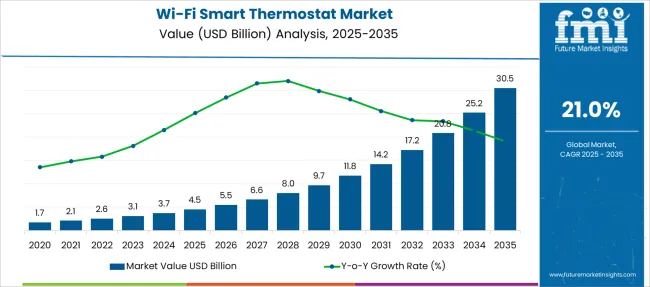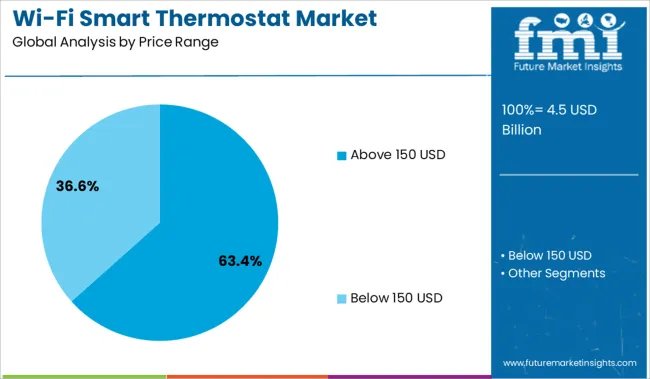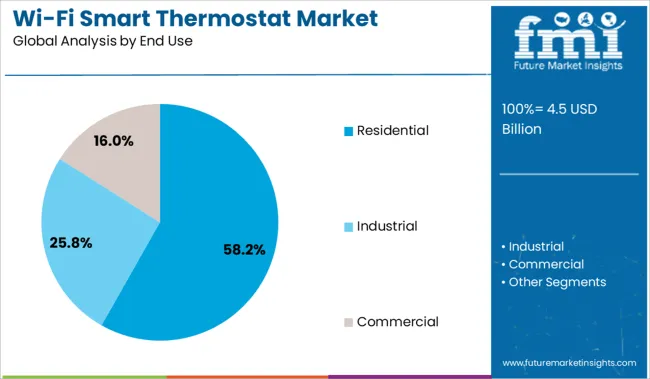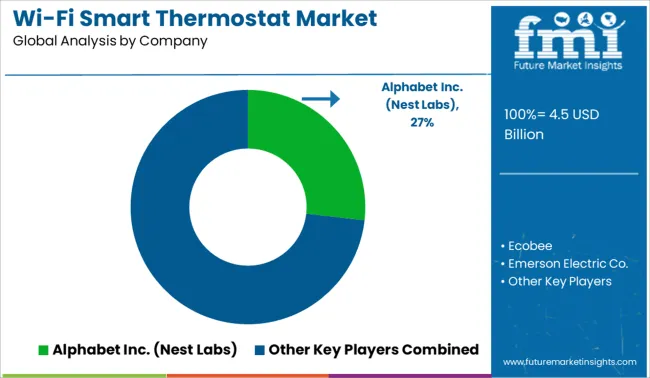The Wi-Fi Smart Thermostat Market is estimated to be valued at USD 4.5 billion in 2025 and is projected to reach USD 30.5 billion by 2035, registering a compound annual growth rate (CAGR) of 21.0% over the forecast period.

| Metric | Value |
|---|---|
| Wi-Fi Smart Thermostat Market Estimated Value in (2025 E) | USD 4.5 billion |
| Wi-Fi Smart Thermostat Market Forecast Value in (2035 F) | USD 30.5 billion |
| Forecast CAGR (2025 to 2035) | 21.0% |
The Wi-Fi smart thermostat market is experiencing rapid growth as homeowners increasingly seek energy-efficient solutions for climate control. Growing awareness of smart home technologies and rising energy costs have motivated consumers to adopt thermostats that offer remote temperature management and energy savings. Improvements in device connectivity and user-friendly interfaces have made these products more accessible to a broader audience.
Additionally, government initiatives promoting energy conservation have encouraged the integration of smart thermostats into residential buildings. The expansion of smart home ecosystems and rising consumer demand for convenience and sustainability are expected to further propel market growth.
Segment leadership is anticipated to come from the above 150 USD price range, which balances advanced features with affordability, and the residential end-use segment, reflecting the growing trend of smart home adoption.
The market is segmented by Price Range and End Use and region. By Price Range, the market is divided into Above 150 USD and Below 150 USD. In terms of End Use, the market is classified into Residential, Industrial, and Commercial. Regionally, the market is classified into North America, Latin America, Western Europe, Eastern Europe, Balkan & Baltic Countries, Russia & Belarus, Central Asia, East Asia, South Asia & Pacific, and the Middle East & Africa.

The above 150 USD price range segment is expected to account for 63.4% of the Wi-Fi smart thermostat market revenue in 2025, maintaining dominance due to the inclusion of advanced functionalities. Devices in this range typically offer features such as learning algorithms, voice control compatibility, and integration with multiple smart home platforms.
Consumers have shown willingness to invest in higher-priced models that provide energy savings and enhanced convenience. The balance between price and technological sophistication has made this segment attractive to tech-savvy homeowners looking for long-term value.
As innovation continues to add features without compromising usability, the demand for premium-priced smart thermostats is expected to remain strong.

The residential segment is projected to contribute 58.2% of the Wi-Fi smart thermostat market revenue in 2025, positioning it as the leading end-use category. Growth in this segment is driven by the increasing number of smart home installations and the preference for energy-efficient appliances.
Homeowners are prioritizing comfort and control, adopting smart thermostats to optimize heating and cooling while reducing utility bills. The rise in urban housing developments equipped with smart infrastructure has further expanded the market.
Consumer interest in home automation and remote management capabilities has supported widespread adoption. With energy conservation becoming a household priority, the residential segment is expected to sustain its leading position in the market.
The global Wi-Fi smart thermostat market trends are shaped by the continuous advancement in sensor technologies, increasing smartphone users as well as expanding wireless telecommunication infrastructure. Rising customer preferences for cloud-based solutions as well as expanding IOTs applications has compelled the manufacturers to spur the uptake of smart programmable thermostats, expanding the Wi-Fi smart thermostat market share.
The sales of Wi-Fi smart thermostat are likely to spur owing to the simple set-up procedures help in saving energy and enables much more comfortable environments in businesses and homes. The study delivers detailed overview of parent markets - Bluetooth and ZigBee based smart thermostat- to create a comparative analysis as to how the sales of Wi-Fi smart thermostat contributes to their overall growth.
Since it lowers installation and maintenance costs, offers greater flexibility and scalability, and improves connectivity, positively influencing the Wi-Fi smart thermostat market outlook. Recently, the market is fostered by new technologies like versatile sensors, occupancy sensors, communicating thermostats are tested, and integrated into building/HVAC applications due to the Internet of Things' (IoT) quick development.
The maintenance of a comfortable temperature in structures like homes and buildings is one of the main goals of smart cities, improving the Wi-Fi smart thermostat market trends and forecast. Smart HVAC systems can reduce energy costs and increase productivity for households, businesses, and the government by integrating IoT sensors with thermostats.
The government and businesses could, therefore, improve the gadgets and programmes to guarantee proper energy optimization in smart building and city projects and demand may rise as a result of the increased focus and usage of the device.
North America is anticipated to be at the forefront of the Wi-Fi smart thermostat market, with a revenue share of 34.6% in 2025. Among the entities that fall under this category are buildings and companies that are owned by the city, as well as colleges, private citizens, hospitals, and non-profits.
In order to change the physical infrastructure and promote wise resource allocation, this factor will almost certainly require behavioural economics, sensor technology, and gamification. These cities might start implementing technologies that employ algorithms and sensors and gradually raise heating and cooling efficiency in order to become more energy-efficient, influencing the Wi-Fi smart thermostat market future trends.
Germany, France, Italy, Spain, the UK, and the rest of Europe comprise the segments of the Europe market, contributing to the region’s Wi-Fi smart thermostat market share of 20.4% in 2025.
Due to the increasing adoption of smart energy solutions across a range of industries and commercial buildings, Europe is likely to dominate the market for Wi-Fi smart thermostats in the years to come.
The rapid adoption of smart infrastructure and the escalating demand for energy management solutions are encouraging European consumers to accept Wi-Fi smart thermostats. Additionally, the market development in the region is being further fuelled by the growing adoption of IoT and AI-based technologies in the region.
Mysa is a smart wi-fi thermostat for applications related to the connected home.
It is made to function with electric baseboard heaters, fan-forced heaters, and in-floor heaters that are powered by high-voltage heating systems. It gains knowledge of how long it takes to heat a space so that it can adjust itself without user input.
The features include vacation mode and location enabled, which turns on or off when they sense your presence. These are able to work with Google Home, Amazon Echo, and Apple Homekit. For remote monitoring and control, the company also offers a companion app that works with iOS and Android devices. Prices as of March 2020 are USD 125.

Some of the major market players include Emerson Electric Co., Honeywell International Inc., Ecobee, Inc., Johnson Controls, Control4 Corporation, Nest Labs Inc., Schnieder Electric SE, Nortek, Inc., Ingersoll Rand plc., and Tado GmbH.
To consolidate their position in the Wi-Fi smart thermostat market, these key players have implemented strategies like mergers and acquisitions, product portfolio expansion, geographic expansion, collaborations, and agreements.
| Report Attribute | Details |
|---|---|
| Growth Rate | CAGR of 21.0% from 2025 to 2035 |
| Base Year for Estimation | 2024 |
| Historical Data | 2020 to 2024 |
| Forecast Period | 2025 to 2035 |
| Quantitative Units | Revenue in USD Million and CAGR from 2025 to 2035 |
| Report Coverage | Revenue Forecast, Volume Forecast, Company Ranking, Competitive Landscape, Growth Factors, Trends and Pricing Analysis |
| Segments Covered | Price Range, End Use, Region |
| Regions Covered | North America; Latin America; Western Europe; Eastern Europe; Asia Pacific; Japan; The Middle East and Africa |
| Key Countries Profiled | USA, Canada, Brazil, Argentina, Germany, UK, France, Spain, Italy, Nordics, BENELUX, Australia & New Zealand, China, India, ASEAN, GCC, South Africa |
| Key Companies Profiled | Emerson Electric Co.; Honeywell International Inc.; Ecobee, Inc.; Johnson Controls; Control4 Corporation; Nest Labs Inc.; Schnieder Electric SE; Nortek, Inc.; Ingersoll Rand plc.; Tado GmbH. |
| Customization | Available Upon Request |
The global wi-fi smart thermostat market is estimated to be valued at USD 4.5 billion in 2025.
The market size for the wi-fi smart thermostat market is projected to reach USD 30.5 billion by 2035.
The wi-fi smart thermostat market is expected to grow at a 21.0% CAGR between 2025 and 2035.
The key product types in wi-fi smart thermostat market are above 150 usd and below 150 usd.
In terms of end use, residential segment to command 58.2% share in the wi-fi smart thermostat market in 2025.






Our Research Products

The "Full Research Suite" delivers actionable market intel, deep dives on markets or technologies, so clients act faster, cut risk, and unlock growth.

The Leaderboard benchmarks and ranks top vendors, classifying them as Established Leaders, Leading Challengers, or Disruptors & Challengers.

Locates where complements amplify value and substitutes erode it, forecasting net impact by horizon

We deliver granular, decision-grade intel: market sizing, 5-year forecasts, pricing, adoption, usage, revenue, and operational KPIs—plus competitor tracking, regulation, and value chains—across 60 countries broadly.

Spot the shifts before they hit your P&L. We track inflection points, adoption curves, pricing moves, and ecosystem plays to show where demand is heading, why it is changing, and what to do next across high-growth markets and disruptive tech

Real-time reads of user behavior. We track shifting priorities, perceptions of today’s and next-gen services, and provider experience, then pace how fast tech moves from trial to adoption, blending buyer, consumer, and channel inputs with social signals (#WhySwitch, #UX).

Partner with our analyst team to build a custom report designed around your business priorities. From analysing market trends to assessing competitors or crafting bespoke datasets, we tailor insights to your needs.
Supplier Intelligence
Discovery & Profiling
Capacity & Footprint
Performance & Risk
Compliance & Governance
Commercial Readiness
Who Supplies Whom
Scorecards & Shortlists
Playbooks & Docs
Category Intelligence
Definition & Scope
Demand & Use Cases
Cost Drivers
Market Structure
Supply Chain Map
Trade & Policy
Operating Norms
Deliverables
Buyer Intelligence
Account Basics
Spend & Scope
Procurement Model
Vendor Requirements
Terms & Policies
Entry Strategy
Pain Points & Triggers
Outputs
Pricing Analysis
Benchmarks
Trends
Should-Cost
Indexation
Landed Cost
Commercial Terms
Deliverables
Brand Analysis
Positioning & Value Prop
Share & Presence
Customer Evidence
Go-to-Market
Digital & Reputation
Compliance & Trust
KPIs & Gaps
Outputs
Full Research Suite comprises of:
Market outlook & trends analysis
Interviews & case studies
Strategic recommendations
Vendor profiles & capabilities analysis
5-year forecasts
8 regions and 60+ country-level data splits
Market segment data splits
12 months of continuous data updates
DELIVERED AS:
PDF EXCEL ONLINE
Smart School Bus Platform Market Size and Share Forecast Outlook 2025 to 2035
Smart Home Wireless Smoke Detector Market Size and Share Forecast Outlook 2025 to 2035
Smart Bus Platform Market Size and Share Forecast Outlook 2025 to 2035
Smart Vision Processing Chips Market Size and Share Forecast Outlook 2025 to 2035
Smart Touch Screen Scale Market Size and Share Forecast Outlook 2025 to 2035
Smart Magnetic Drive Conveyor System Market Size and Share Forecast Outlook 2025 to 2035
Smart Wheelchair market Size and Share Forecast Outlook 2025 to 2035
Smart Mining Technologies Market Size and Share Forecast Outlook 2025 to 2035
Smart Parking Market Size and Share Forecast Outlook 2025 to 2035
Smart Digital Valve Positioner Market Forecast and Outlook 2025 to 2035
Smart Card IC Market Size and Share Forecast Outlook 2025 to 2035
Smart-Tag Inlay Inserters Market Analysis - Size and Share Forecast Outlook 2025 to 2035
Smart TV Market Forecast and Outlook 2025 to 2035
Smart/AI Toy Market Size and Share Forecast Outlook 2025 to 2035
Smart Locks Market Size and Share Forecast Outlook 2025 to 2035
Smart Sprinkler Controller Market Size and Share Forecast Outlook 2025 to 2035
Smart Indoor Gardening System Market Size and Share Forecast Outlook 2025 to 2035
Smart Building Delivery Robot Market Size and Share Forecast Outlook 2025 to 2035
Smart Watch Market Size and Share Forecast Outlook 2025 to 2035
Smart Label Market Size and Share Forecast Outlook 2025 to 2035

Thank you!
You will receive an email from our Business Development Manager. Please be sure to check your SPAM/JUNK folder too.
Chat With
MaRIA